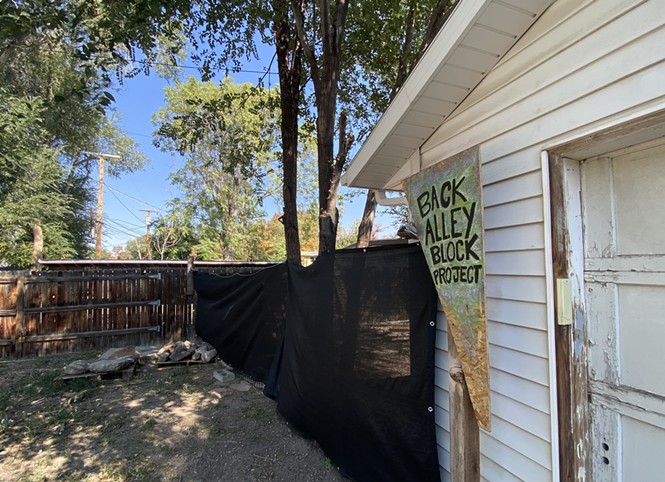Memory Lanes
Pilot program works with residents to rehabilitate alleyways
By Benjamin Wood @BjaminWoodLIBERTY WELLS—Shelley Carpenter says the alley that runs behind her home is a "magical" space, where neighbors gather in the evenings to walk their dogs, have a drink or watch the fireworks from Smith's Ballpark nearby.
But the alley also has a "checkered past," she said, as the scene of vandalism, garbage dumping, drug use, prostitution and at least one high-speed chase that ended when the fleeing driver crashed into a utility pole.
"We've all been broken into more times than we can count," said Carpenter.
With some help from the city, Carpenter and her neighbors are working to permanently reclaim the alley as a public asset.
Work began in September to clean out and repave the space—which runs from Browning Ave. to Kensington Ave. between 300 East and Roberta Street—using recycled asphalt. And when that city-led phase is completed this fall, homeowners and the Liberty Wells Community Council plan to continue the rejuvenation with artwork, public amenities and lighting.
"The idea was not to create a community policing movement," Carpenter said, "but rather, to fill the space with positive energy. That, in and of itself, will push out a lot of the negative energy."
At her own home, Carpenter talks about installing a rockscaping project, or perhaps a solar-powered water feature.
"Each of the residents is sort of responsible for their own space," she said. "People are looking at owl boxes and little libraries or bike stations. The idea is it should only need as much maintenance as you're willing to do."
David Jones, a project manager with the city Engineering Department, said the Liberty Wells project is the first in what could be a broad alleyway rehabilitation effort. Roughly $200,000 from the Funding Our Future bond was set aside for the pilot, he said, which is expected to pay for three alley resurfacings this year.
"[City] Engineering will scrub the alley, remove vegetation, level it, bring in recycled asphalt and apply a coating to the asphalt to make it a drivable surface," he said. "If we can find community support for these projects, the placemaking initiatives can [then] take place at a localized level."
Jones said there are more than 1,400 alleys in the city, which equates to more than 50 miles of off-street, public rights-of-way. While many have fallen into states of disuse and dereliction, a regularly-utilized alley can provide a gathering space or transportation alternative through neighborhoods.
"Alleys create a sense of place for the neighborhood," Jones said. "They provide a quieter, slower space for dog walks or family bike rides."
Jones said Salt Lake City's alleys were initially well-trafficked corridors for deliveries and services. Many homeowners still rely on alleys for garages and property access, he said, but there are opportunities to lean into these existing corridors for things like mother-in-law apartments or small, home-based businesses.
"That's how [residents] got their coal, got their milk delivery," he said. "They were areas of commerce."
Carpenter said the Liberty Wells project grew out of her and other neighbors cleaning up around their individual properties. After the outbreak of Coronavirus, and following last year's devastating wind storm, more and more residents started spending time outside their homes and looking at repairs and improvements around their property lines.
She pointed out that Whittier Elementary lies at the south end of the alley, and if other nearby corridors are able to be maintained, then children can have a safe route to school that avoids interacting with cars.
"The thousand-foot level idea is that eventually it's nice enough that it's an extension of everyone's back yard we can all share," she said. "Say you had a family reunion in your back yard and needed space—you could spill out into the alley."
Even with the frequency of crime and vandalism, Carpenter said she's come to recognize how lucky she and her neighbors are to be adjacent to an open corridor.
"There are so many public spaces that are being privatized," she said. "I'm in a serious relationship with this block. I signed a 30-year mortgage, and it's like a marriage license."
In a prepared statement, Mayor Erin Mendenhall said her administration is looking for opportunities to not only improve alleys, but also reimagine their value as a public space.
"Our alleyways are a tremendous and underutilized City asset that I've long wanted to help neighbors positively activate," Mendenhall said.
And Caitlin Lutsch, chairwoman of the Liberty Wells Community Council, said the project helps to preserve the environment of the neighborhood.
"Going forward, we see the activation of our alleys as a way to celebrate Liberty Wells' unique character while preserving public space, bringing neighbors together, and enriching the sometimes less-appreciated niches of our community," she said.
More by Benjamin Wood
-
‘Festival street,' Green Loop and transit-oriented density anchor latest SLC plans for west downtown.
Arrested Development
- Apr 17, 2024
-
Former Salt Lake City mayor and celebrated Utah Democrat Ted Wilson dies at age 84.
Ted Led
- Apr 11, 2024
-
Salt Lakers are about to miss an opportunity for reconnection over and under I-15.
Small Lake City
- Mar 27, 2024
- More »
Latest in News
Readers also liked…
-
Raise a glass for E.L.T Harrison, architect of the Beerhive building on Main
Small Lake City
- Oct 11, 2023




